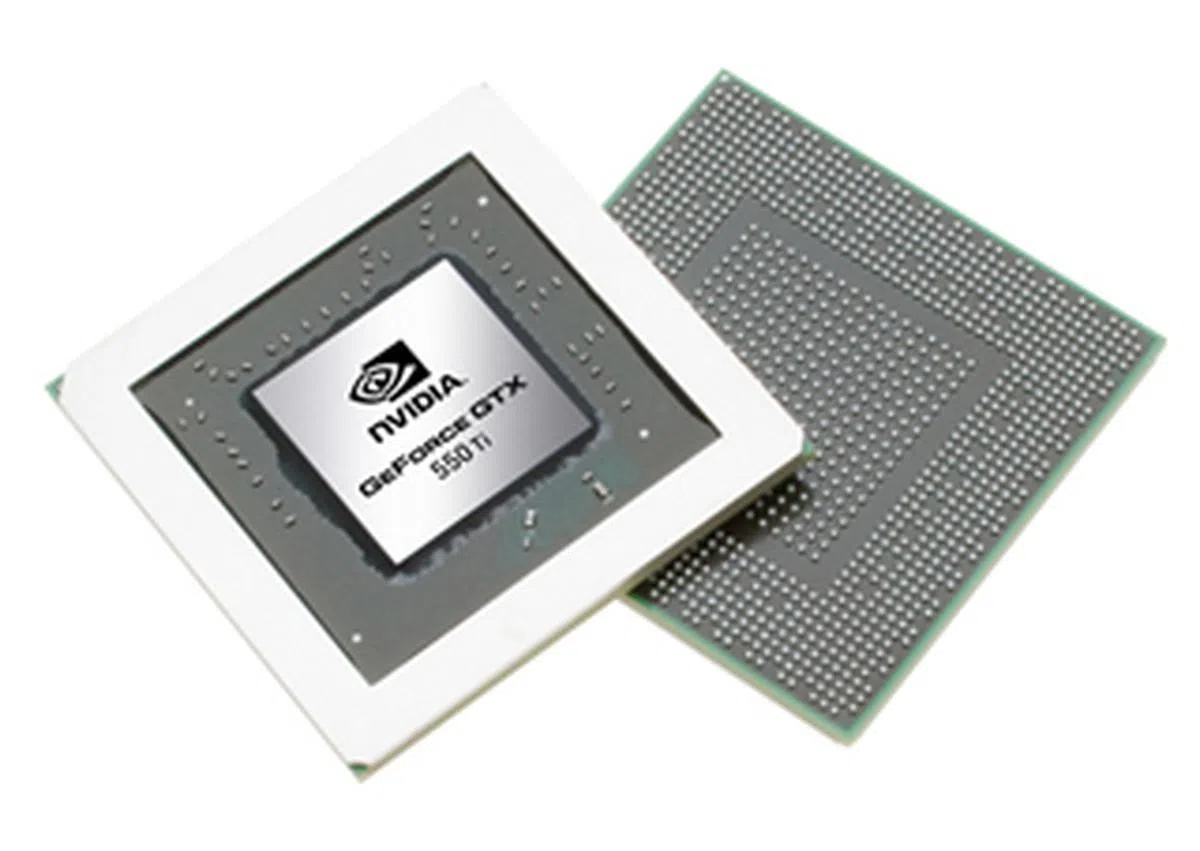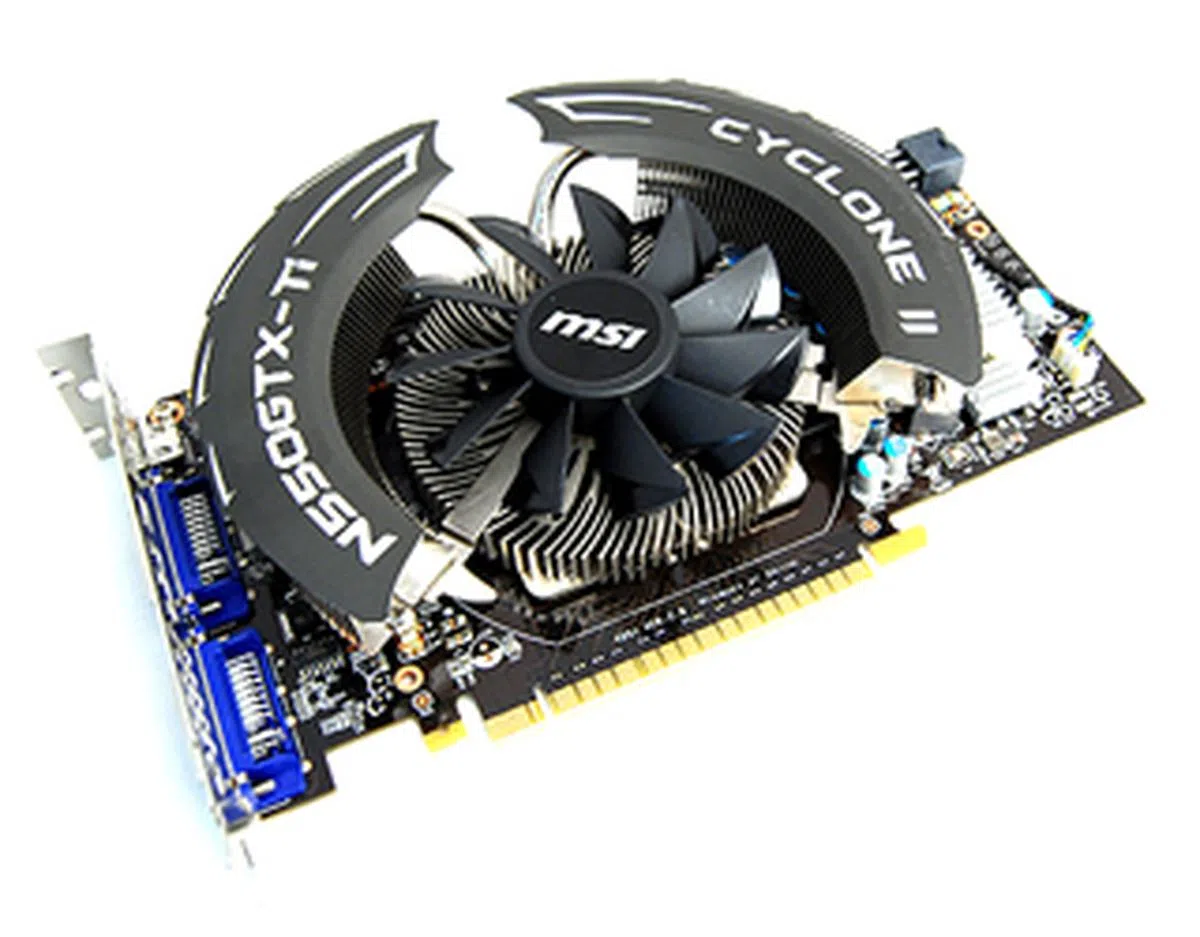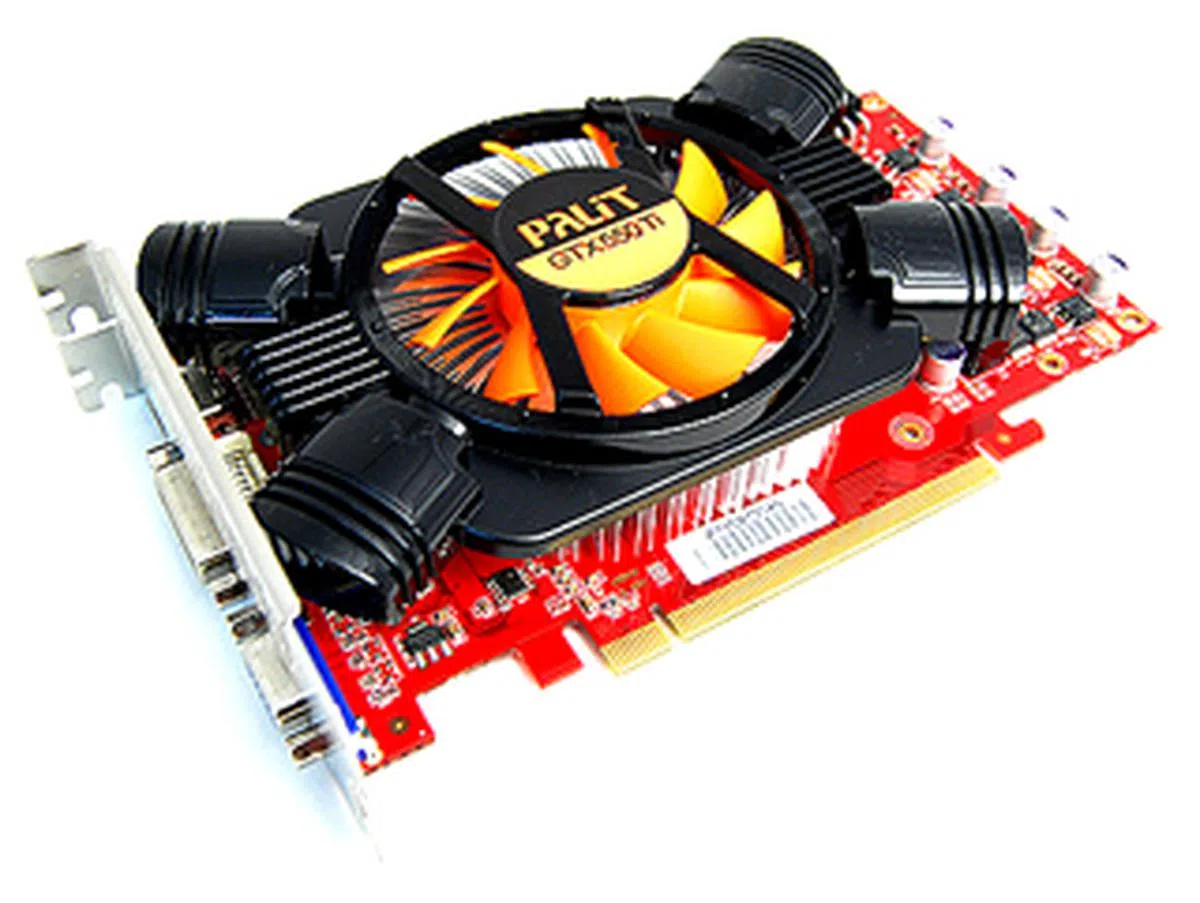NVIDIA GeForce GTX 550 Ti - Rejuvenating the Mainstream
NVIDIA drew first blood this year with the GeForce GTX 560 Ti and they are now following up with the GeForce GTX 550 Ti to refresh the mainstream market for casual gamers and bargain hunters. Besides performance for the GTX 550 Ti, check out how MSI's new Cyclone and Palit's Sonic editions fared in our testing.
By Kenny Yeo -
Mainstream Refresh
NVIDIA geared up for the new year in a big way by releasing the fantastic . Packing 384 CUDA cores, the GeForce GTX 560 Ti shook up the mainstream to high-end markets and forced AMD to cut prices of both 2GB and 1GB variants of the and also the Radeon HD 6870, effectively removing the Radeon HD 6870 out of the picture and positioning the beefier Radeon HD 6950 as the GeForce GTX 560 Ti’s main competitor. Nevertheless, in spite of this move, the GeForce GTX 560 Ti remained to be really popular.
And now, NVIDIA is following up with the new GeForce GTX 550 Ti, in an attempt to rejuvenate their mainstream Fermi offerings. In terms of specifications, the GeForce GTX 550 Ti is very similar to the older GeForce GTS 450, but with some differences. While the two parts continue to have 192 CUDA cores, the new GeForce GTX 550 Ti gets a wider 192-bit memory bus interface for increased memory bandwidth. To accommodate a 1GB framebuffer on a 192-bit memory interface, NVIDIA has ensured that the GeForce GTX 550 Ti’s memory controller is capable of supporting mixed density memory chips.
Elsewhere, NVIDIA has also improved the anti-aliasing performance of the GeForce GTX 550 Ti by increasing the number of raster operating units (ROPs). The GeForce GTX 550 Ti has 24 ROPs, an increase of eight, and hopefully this will pay dividends when we enable anti-aliasing.

NVIDIA is continuing their top to bottom refresh of their Fermi line-up with the GeForce GTX 550 Ti, a 192 CUDA core card for mainstream users.
Other than the increase in the number of ROPs, the GeForce GTX 550 Ti also gets much higher clock speeds. In stock form, a reference GeForce GTX 550 Ti will be running at a staggering 900MHz at the core (that's close to a full 1GHz), 1800MHz at the shaders, and 4100MHz DDR at the memory. Comparing this to the older GeForce GTS 450 equivalent clock speeds 783MHz, 1566MHz and 3608MHz DDR, the clock speeds of the GeForce GTX 550 Ti a substantial increase of around 14%. which, along with the increased memory bandwidth and bump in ROPs count, should give a good increase in performance.
All things considered, the increased memory bandwidth, bump in ROPs count, and higher clock speeds, should give the GeForce GTX 550 Ti a good increase in performance over the older GeForce GTS 450. But before we continue, here is a quick look at how NVIDIA’s new part compares against its closest rivals.
Model | NVIDIAGeForce
GTX 550 Ti | NVIDIAGeForce GTS 450 | NVIDIAGeForce GTX 560 Ti | NVIDIAGeForce GTX 460 | AMDRadeon HD6850 | ATI Radeon HD 5770 | ATIRadeon HD 5750 |
Core Code | GF116 | GF106 | GF114 | GF104 | Barts PRO | Juniper XT | Juniper PRO |
Transistor Count | 1170 million | 1170 million | 1950 million | 1950 million | 1700 million | 1040 million | 1040 million |
Manufacturing Process | 40nm | 40nm | 40nm | 40nm | 40nm | 40nm | 40nm |
Core Clock | 900MHz | 783MHz | 822MHz | 675MHz | 775MHz | 850MHz | 700MHz |
Stream Processors | 192 Stream Processors | 192 Stream Processors | 384 Stream Processors | 336 Stream Processors | 960 Stream processing units | 800 Stream processing units | 720 Stream processing units |
Stream Processor Clock | 1800MHz | 1566MHz | 1644MHz | 1350MHz | 775MHz | 850MHz | 700MHz |
Texture Mapping Units (TMU) or Texture Filtering (TF) units | 32 | 32 | 64 | 56 | 48 | 40 | 36 |
Raster Operator units (ROP) | 24 | 16 | 32 | 24 | 32 | 16 | 16 |
Memory Clock | 4100MHz GDDR5 | 3608MHz GDDR5 | 4008MHz GDDR5 | 3600MHz GDDR5 | 4000MHz GDDR5 | 4800MHz GDDR5 | 4600MHz GDDR5 |
DDR Memory Bus | 192-bit | 128-bit | 256-bit | 192 / 256-bit | 256-bit | 128-bit | 128-bit |
Memory Bandwidth | 98.5GB/s | 57.7GB/s | 128GB/s | 86.4 / 115.2GB/s | 128GB/s | 76.8GB/s | 73.6GB/s |
PCI Express Interface | PCIe ver 2.0 x16 | PCIe ver 2.0 x16 | PCIe ver 2.0 x16 | PCIe ver 2.0 x16 | PCIe ver 2.0 x16 | PCIe ver 2.0 x16 | PCIe ver 2.0 x16 |
Molex Power Connectors | 1 x 6-pin | 1 x 6-pin | 2 x 6-pin | 2 x 6-pin | 1 x 6-pin | 1 x 6-pin | 1 x 6-pin |
Multi GPU Technology | SLI | SLI | SLI | SLI | CrossFireX | CrossFireX | CrossFireX |
DVI Output Support | 2 x Dual-Link | 2 x Dual-Link | 2 x Dual-Link | 2 x Dual-Link | 1 x Single-Link, 1 x Dual-Link | 2 x Dual-Link | 2 x Dual-Link |
HDMI | 1 (mini-HDMI) | 1 (mini-HDMI) | 1 (mini-HDMI) | 1 (mini-HDMI) | 1 | 1 | 1 |
DisplayPort | None | None | None | None | 1 (DisplayPort 1.2) | 1 | 1 |
HDCP Output Support | Yes | Yes | Yes | Yes | Yes | Yes | Yes |
Street Price | Launch price: US$159 | ~US$129 | ~US$249 | ~US$199 | ~US$189 | ~US$139 | ~US$109 |
The MSI N550GTX-Ti Cyclone II OC
Lately, MSI has been updating the designs of their custom cooler and we have already seen them done so with their third-generation Twin Frozr III cooler. Now, they are also refreshing the design of their Cyclone cooler and the MSI N550GTX-Ti Cyclone II OC card we have here is one of the first cards to make use of this new second-generation Cyclone II cooler.
The most notable change to the cooler is the inclusion of what MSI calls “Propeller Blades”. These blades are angled such that more air is forced onto the heatsink. Speaking of which, the heatsink on this new Cyclone II cooler is visibly larger. Furthermore, the card comes with the usual Military Class suite of components such as solid capacitors and ferrite chokes to help the card run more cool and efficiently. With these improvements, hopefully we will see the card turn in a good performance in our temperature test.
Finally, as the “OC” suffix denotes, this card is factory overclocked at 950MHz at the core, 1900MHz at the shaders and 4300MHz DDR at the memory - a substantial bump of 50MHz at the core and 200MHz DDR at the memory.

The MSI N550GTX-Ti Cyclone II OC uses an improved design of the original Cyclone cooler that was used on MSI's mainstream graphics cards.

The card packs the usual twin DVI ports and single mini-HDMI port.

The cooler has been redesigned with "Propeller Blades" and a visibly larger heatsink.
The Palit Geforce GTX 550 Ti Sonic
Palit’s Sonic series of cards have also been some of the quickest in the market and this card is no different. Factory overclocked at a full 1GHz at the core, 2000MHz at the shaders and 4400MHz DDR at the memory, this card has significantly higher clock speeds when compared to a reference card, which should also translate to some decent performance increases. To keep the card cool Palit has decided to simply go for a custom cooler to keep the card’s temperatures under control. It has a blocky single-fan cooler with a radial design heatsink, which is quite similar to the base heatsink employed by the MSI Cyclone cooler. While solid capacitors were noted on the PCB, ferrite chokes were given a miss on this card. Perhaps a cost saving measure at this mainstream segment.

The Palit GeForce GTX 550 Ti Sonic has the familiar black and orange theme that is actually quite attractive really.

The Palit card offers a DVI port, a VGA port, and a single full-sized HDMI port.

The Palit card uses a radial heatsink design similar to that employed by MSI's Cyclone cooler. The only difference is that this card doesn't have the twin peripheral heatsink arrays by the sides.
Test Setup
We’ll be evaluating the three cards using our X58 testbed which has the following specifications:
- Intel Core i7-975 (3.33GHz)
- Gigabyte GA-EX58-UD4P motherboard
- 3 x 1GB DDR3-1333 G.Skill memory in triple channel mode
- Seagate 7200.10 200GB SATA hard drive
- Windows 7 Ultimate
Since we didn’t get a reference card from NVIDIA, we will be downclocking the MSI card to simulate the performance of a reference GeForce GTX 550 Ti. We are interested to see how the new GeForce GTX 550 Ti slots into NVIDIA’s current line-up of Fermi cards. Crucially, how much faster would it be compared to the old GeForce GTS 450 and how would it measure up against the GeForce GTX 460 and also the recently launched GeForce GTX 560 Ti.
Against AMD/ATi, we’ll be comparing the GeForce GTX 550 Ti against their latest mainstream Northern Islands offering, the Radeon HD 6850. We have also included results from their older mainstream Radeon HD 5770 and HD 5750 for comparison.
As for the two custom edition cards, we are expecting them to post significant gains over a reference GeForce GTX 550 Ti. To add, we are expecting the much higher clocked Palit card to come out tops in the speed stakes.
The cards tested and driver versions used:
- MSI N550GTX-Ti Cyclone II 1GB GDDR5 (ForceWare 266.71)
- Palit GeForce GTX 550 Ti Sonic 1GB GDDR5 (ForceWare 266.71)
- NVIDIA GeForce GTS 450 1GB GDDR5 (ForceWare 266.56)
- NVIDIA GeForce GTX 560 Ti 1GB GDDR5 (ForceWare 266.56)
- NVIDIA GeForce GTX 460 1GB GDDR5 (ForceWare 266.58)
- AMD Radeon HD 6850 1GB GDDR5 (Catalyst 10.12)
- ATI Radeon HD 5770 1GB GDDR5 (Catalyst 11.2)
- ATI Radeon HD 5750 1GB GDDR5 (Catalyst 11.2)
The list of benchmarks used:
- Futuremark 3DMark Vantage
- Futuremark 3DMark 11
- Crysis Warhead
- Far Cry 2
- Warhammer: Dawn of War 2
- Battlefield Bad Company 2
- “Heaven" from Unigine v2.1
- S.T.A.L.K.E.R.: Call of Pripyat
FutreMark 3DMark 11
Beginning with the new 3DMark 11 benchmarking utility, we can see that the improvements of the GeForce GTX 550 Ti has enabled it to outscore the older GeForce GTS 450. Stock vs. stock, the reference GeForce GTX 550 Ti outscored the GeForce GTS 450 by about 20%. However, the GeForce GTX 550 Ti was no match for the more powerful GeForce GTX 560 Ti, which easily managed the highest scores in this comparison. The GeForce GTX 460 too is still some way ahead of the GTX 550 Ti.
Against AMD/ATI’s offerings, the GeForce GTX 550 Ti outscored the older Radeon HD 5750 and was a on par with the Radeon HD 5770. We'll keep close tabs to see if this performance level is evident throughout our benchmarking.
The two custom GeForce GTX 550 Ti cards on the other hand were appreciably faster than a reference card as evidenced by their scores, with the higher clocked Palit card racking up the highest scores amongst the three GeForce GTX 550 Ti representatives.

FutureMark 3DMark Vantage Results
3DMark Vantage revealed similar findings to 3DMark 11, with the GeForce GTX 550 Ti coming nicely in between the old GeForce GTS 450 and the GTX 460. Thanks to the improvements made, the GeForce GTX 550 Ti managed about 10% to 15% higher scores compared to the GeForce GTS 450, which is a nice increment in performance.
The GeForce GTX 550 Ti was also able to match the Radeon HD 5770 and even managed to eke out a slight advantage on the “Extreme” preset. Clearly, the increase in number of ROPs has helped the GeForce GTX 550 Ti in high-end anti-aliasing applications.
Moving on, the two custom GeForce GTX 550 Ti recorded noticeable gains in 3DMarks when compared to the reference card, with the Palit expectedly being the top GeForce GTX 550 Ti performer.

Crysis Warhead and Far Cry 2 Results
On Crysis Warhead, the GeForce GTX 550 Ti found itself sandwiched between the GeForce GTS 450 and GTX 460. It performed more closely to the GeForce GTS 450, but it was still appreciably faster by more than 10%. Still, given the mainstream intentions of the card, it didn’t manage very playable frame rates on Crysis Warhead.
Again, we found that the GeForce GTX 550 Ti was a match for the Radeon HD 5770, but this time round, the Radeon card managed to claw its way back to a marginal lead when we enabled anti-aliasing. Also, the GeForce GTX 550 Ti was able to outperform the less powerful Radeon HD 5750, but was no match for the newer Radeon HD 6850.


NVIDIA cards have traditionally done well on the Far Cry 2 benchmark and so it was no surprise to see the GeForce GTX 550 Ti cards managing some respectable results. The GeForce GTX 550 Ti continued to come in between the GeForce GTS 450 and GTX 460, but here, it was able to match the new Radeon HD 6850 from AMD. And thanks to its enhancements, the GeForce GTX 550 Ti was more than 20% faster than the GeForce GTS 450, which is impressive.


Dawn of War 2 and Battlefield Bad Company 2 Results
On Dawn of War 2, the GeForce GTX 550 Ti posted impressive gains over the older GeForce GTS 450. On a whole, we recorded about a 25% increase in performance, which is certainly worth commending. It was still some ways off compared to the GeForce GTX 460, especially when we upped the resolution.
Against the cards from the red camp, the GeForce GTX 550 Ti was unable to match the new Radeon HD 6850, but could comfortably beat the older Radeon HD 5770 and HD 5750.

On Battlefield Bad Company 2, the GeForce GTX 550 Ti was again more than 20% faster than the older GeForce GTS 450. However, the might of the GeForce GTX 460 and GTX 560 Ti was too much for it to match. Also, the GeForce GTX 550 Ti was comfortably quicker than the Radeon HD 5770 by around 20%.
Of the two custom GeForce GTX 550 Ti cards, the higher clocked Palit card come out tops as it was more than 10% faster than a reference clocked card.

Unigine "Heaven" 2.1 Results
NVIDIA’s Fermi cards have usually tackled tessellation heavy applications better than their rivals and Unigine’s “Heaven” benchmarks is one of the most tessellation intensive benchmarks you can find. Unsurprisingly then, the GeForce GTX 550 Ti was able to give the Radeon HD 6850 a run for its money, even if it couldn’t surpass it.
Elsewhere however, while the GeForce GTX 550 Ti was faster than the older Radeon HD 5770 with tessellation enabled, it lost out and performance took a substantial dip when we disabled tessellation and reverted to DirectX10. Furthermore, we noticed that the GeForce GTX 550 Ti's performance takes a significant hit when anti-aliasing is enabled, showing that, in this instance at least, the increased number of ROPs have contributed little to performance.
DirectX 11 Results


DirectX10 Results


S.T.A.L.K.E.R.: Call of Pripyat Results
On S.T.A.L.K.E.R.: Call of Pripyat, the performance of the GeForce GTX 550 Ti continued to find itself between the GeForce GTS 450 and GTX 460. It continued to maintain a 20% performance advantage over the GeForce GTS 450, which is certainly outstanding. However, it continues to trail the GeForce GTX 460 and the newer GTX 560 Ti.
Against the Radeon HD 6850 and HD 5770, the GeForce GTX 550 Ti provided a good fight when we had tessellation enabled. However, when we ran the benchmark on DirectX10 and had tessellation disabled, the Radeons, especially the HD 6850, managed to gain a substantial advantage.
DirectX 11 Results
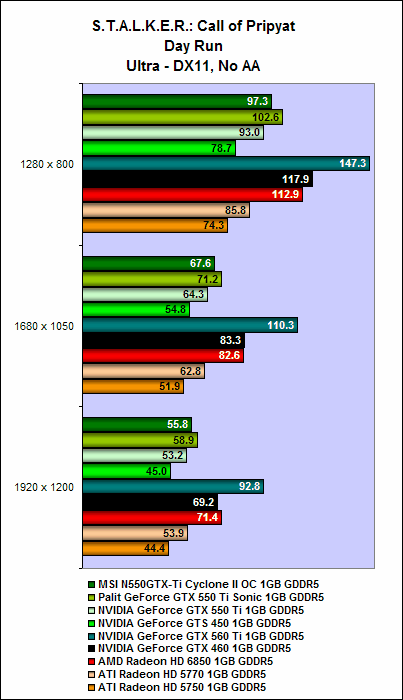 | 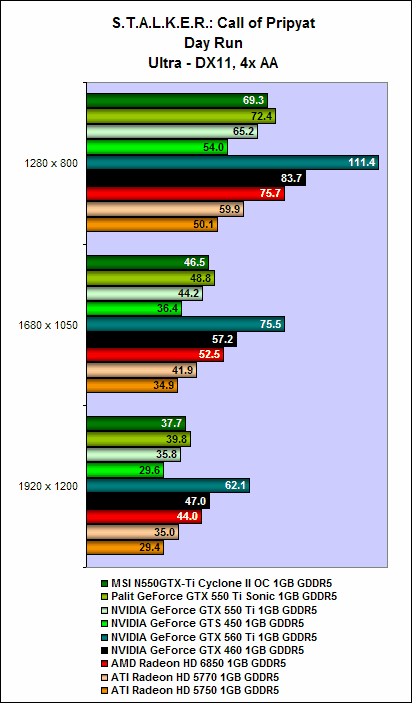 |
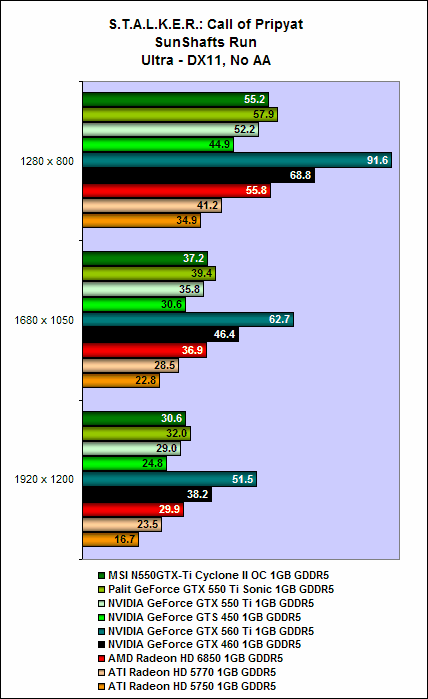 | 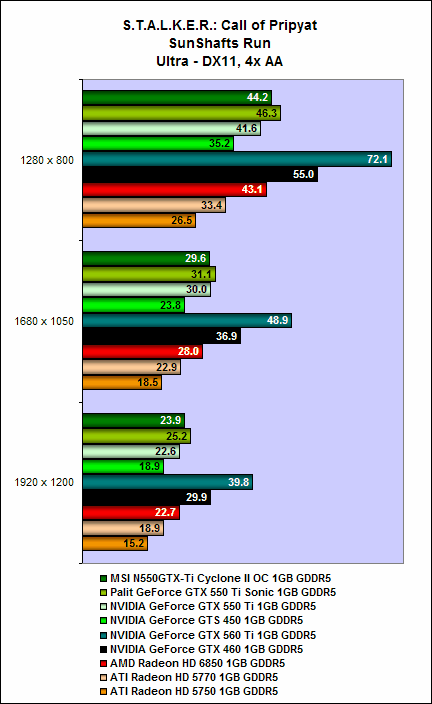 |
DirectX 10 Results
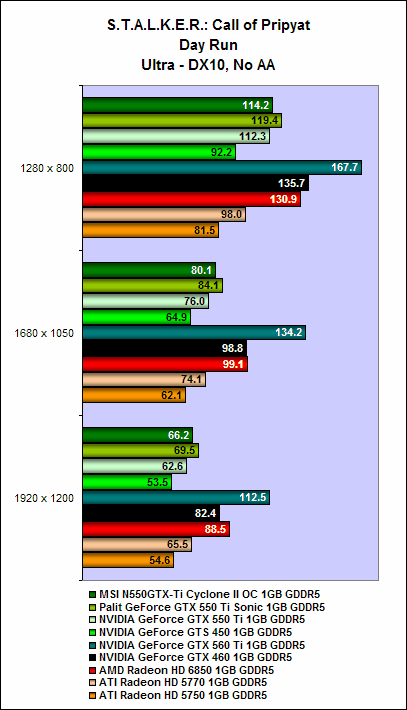 | 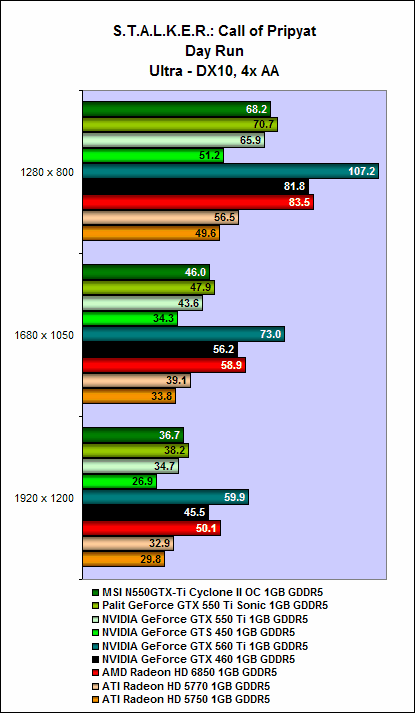 |
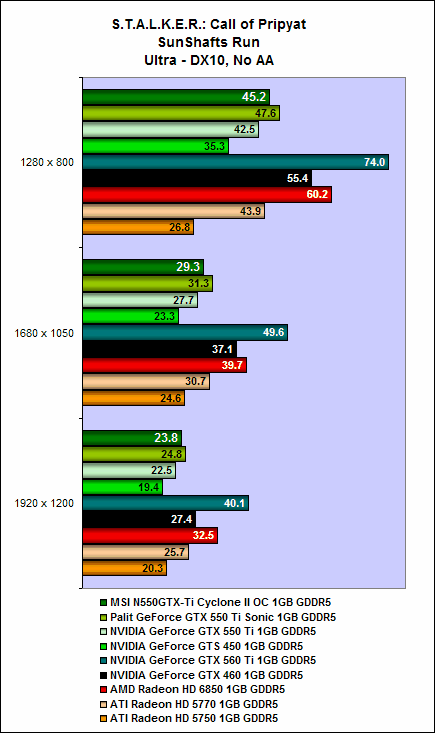 | 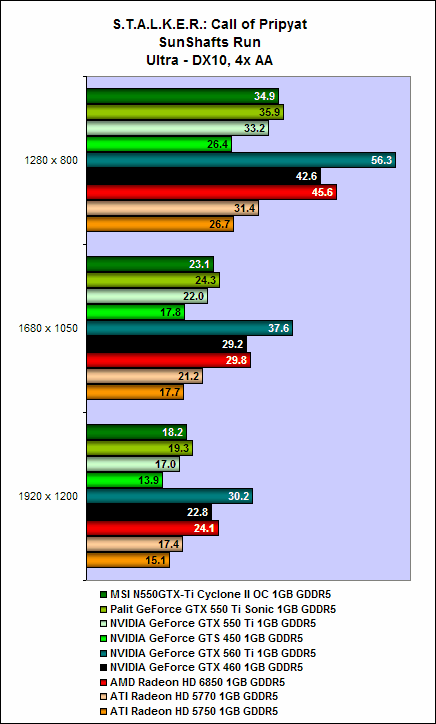 |
Temperature
Since the results of our Reference GeForce GTX 550 Ti were simulated using the MSI card, we cannot include results of it in our temperature and power consumption tests.
Apart from that, MSI’s Cyclone cooler has proven itself to be an effective design and this second-generation cooler with its “Propeller Blades” fan continues this tradition. The MSI N550GTX-Ti Cyclone II recorded an impressive 52 degrees Celsius at load, a whopping 22 degrees Celsius cooler than the Palit card.

Power Consumption
NVIDIA claims that because of changes made at the transistor level, leaking has been greatly reduced such that the GeForce GTX 550 Ti only consumes a little more power compared to the GeForce GTS 450 despite having much higher clock speeds. Admittedly, this hard is a little difficult to verify considering we don’t have reference card on hand, but judging from the readings taken from the MSI card, it seems that NVIDIA has done pretty well to keep power consumption figures down. The Palit card on the other hand recorded significantly higher readings, which is not surprising considering its clock speeds. Compared against the Radeon cards however, there's much room for NVIDIA to improve upon.

Overclocking
With the two custom edition cards already sporting such high clock speeds, we were curious to find out just how much further we could push the two cards in our overclocking tests. The MSI N550GTX-Ti Cyclone II OC did impressively in this test, managing an unbelievable 1100MHz at the core and 4900MHz DDR at the memory and achieving 6333 3DMarks - an improvement of 16%.
The Palit card on the other hand managed only 1030MHz at the core and 4450MHz DDR at the memory, giving it 5894 3DMarks - an improvement of 3%.

A Ho-Hum Refresh
Beginning in November last year with the flagship , NVIDIA has systematically refreshed and improved their Fermi offerings. Changes at the transistor level along with slight changes in the configuration of the core have vastly improved not only the performance, but also the power efficiency and thermal characteristics of the new GTX 500 series cards. These tweaks and enhancements have kept NVIDIA competitive even if their rivals, AMD, have already gone ahead and introduced their next-generation Radeon HD 6000 series cards.
And in the same vein, the GeForce GTS 550 Ti offers substantially more performance over the older GeForce GTS 450. In our tests, we found that, thanks to the increase number of ROPs and boosted clock speeds, the new GeForce GTX 550 Ti was about 15% to 20% faster than the GeForce GTS 450.
If you concentrate on the gains alone, certainly, the GeForce GTX 550 Ti does offer substantially more performance. However, it still trails the old GeForce GTX 460 considerably. This was something we mentioned in our review of the GeForce GTS 450 and that hasn’t been successfully rectified with the GeForce GTX 550 Ti, despite NVIDIA’s tweaks.
The gulf between the GeForce GTX 550 Ti and the recently released GTX 560 Ti is even wider, and judging from the fact that NVIDIA has decided to resurrect the “Ti” branding. We won’t be surprised if NVIDIA decided to plug the gap with a none “Ti” or regular GeForce GTX 560 in the future.
With a launch price of around US$149 to US$159, the GeForce GTX 550 Ti is slightly more costly than the GeForce GTS 450, but this is largely justified considering the performance gains and the new chip’s power and thermal characteristics. However, we noticed that there’s a huge price gulf between it and the GeForce GTX 560 Ti, which again reaffirms our speculation that there would be a regular GeForce GTX 560 in the near future.
NVIDIA also choose to price their new part squarely between the Radeon HD 6850 and HD 5770, which is a clever move. It is slightly most pricey than the Radeon HD 5770, but then again it is also somewhat faster. On the other hand, the Radeon HD 6850 is mostly quicker and markedly more so on DirectX 10 applications. Furthermore, it has the usual AMD niceties such as easy configuration of multi-monitor setups. So again, it really boils down to what you need.
On the whole, the GeForce GTX 550 Ti is a decent refresh of the older GeForce GTS 450. It offers improved performance, but sadly not much else. Also, there’s now a really huge gulf between it and the next card in NVIDIA’s new GTX 500 line-up, the GeForce GTX 560 Ti - so it will be interesting to see what NVIDIA comes up with next.

The GeForce GTX 550 Ti offers substantial improvements where performance is concerned, but not much else, unfortunately.
Running at a full 1GHz at the core, it was no surprise that the Palit GeForce GTX 550 Ti Sonic was the quicker of the two cards. Palit’s Sonic series of cards have always been some of the fastest in terms of raw speed and this card lives up to that tradition. Unfortunately, like most of the other Sonic cards, this has come at the price of increased operating temperatures and higher power consumption. Still, at a price of US$159, you’d be hard pressed to find a card that is just as quick out of the box.
The MSI N550GTX-Ti Cyclone II OC might be the slower of the two, but it is a better all-round performer. Where raw frame rates are concerned, it’s marginally slower than the Palit card - by around 5% - but it makes up for it with its much lower operating temperatures and power consumption figures. Thanks to the improved Cyclone II cooler, the MSI was a staggering 22 degrees Celsius cooler when running at load. This also translated to a better overclocking performance, as the MSI card managed a maximum stable overclocking state of 1100MHz at the core and 4900MHz DDR at the memory. Furthermore, despite all the added features of the card, it still comes in at US$159, which makes it a terrific buy if you are in the market of a GeForce GTX 550 Ti card.
|  |
|  |
Our articles may contain affiliate links. If you buy through these links, we may earn a small commission.
